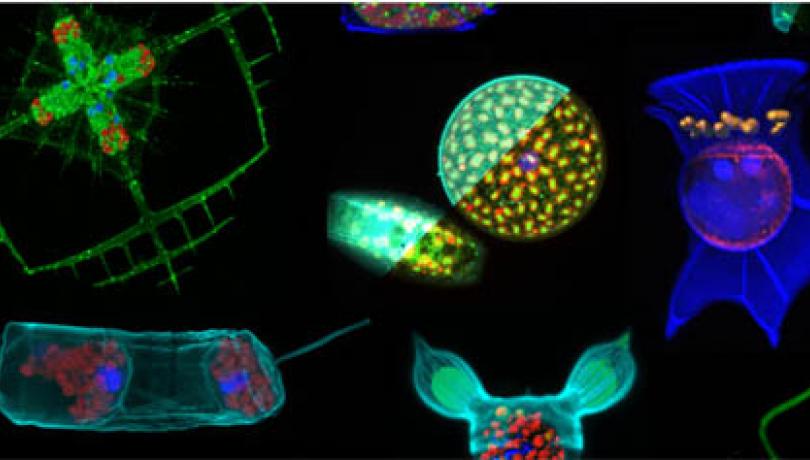An international scientific team, with a large contribution of ICM-CSIC researchers, has obtained the genome of several marine bacterivorous protists and has compared them to the genetic data of natural microbial communities. The results unveil how these bacterivorous distribute across the different regions of the ocean and supports the idea that each species has a specific role in the microbial plankton.

An international scientific team, with a large contribution of ICM-CSIC researchers, has obtained the genome of several marine bacterivorous protists and has compared them to the genetic data of natural microbial communities. The results unveil how these bacterivorous distribute across the different regions of the ocean and supports the idea that each species has a specific role in the microbial plankton.
Terrestrial and marine animals and plants have adapted to different environmental conditions and perform different roles within ecosystems, which determines their distribution on the different regions of the Earth planet. Similarly, it is known that ocean plankton, which includes many microscopic organisms (among them, protists or unicellular eukaryotes) is not a vast mass of individuals randomly grouped. On the contrary, each one belongs to a different species with a specific distribution, according to their adaptation and to the role they perform in the ecosystem.
Now, an international research team led by CNRS scientists and with a large contribution of Instituto de Ciencias del Mar (ICM-CSIC) researchers, is providing the basis to explain the vast phylogenetic diversity within a functional consortium of marine bacterivorous protists, whose role is to predate on marine bacteria and to control their abundances. It is known that this group of bacterivorous protists include many species sharing a similar cell morphology. Data available so far indicated that most of these grazers belonged to uncultured species from the eukaryotic supergroup stramenopiles. As they have never been cultured in the lab, it is extremely difficult to study them.
The research, published in Nature Communications, supports the idea that the vast diversity of bacterial grazers is connected with particular biogeographic distributions and substantial functional specializations. In particular, scientists suggest hypothesis of distinct ecological strategies within particular lineages in terms of cell motility, food spectra, and trophic stages.
In the study, scientists have applied Single-cell genomics techniques combined with metagenomic data, the latest obtained directly from microbial communities retrieved from the environment, in order to get information from these natural communities.
This is, as a matter of fact, one of the innovations of the study, as Ramon Massana, leader of the Spanish team at the ICM-CSIC, explains: “We have analyzed the genome of 40 single cells of protists, which belong to 8 species. Afterwards, we have compared these genomes to the metagenomic data of samples collected over the course of the international expedition Tara Oceans”. The samples were collected from all the world's oceans, at different depths and seasons.
The results of the work unveil how the 8 species are distributed across different seas and regions and, together with the functional specialization detected by Single-cell genomics, supports the idea that bacterial grazers perform diverse roles in the ecosystem.
These findings are the result of a large collaborative effort of complementary scientific teams. Data for Single-cell genomics and metagenomics was collected during the Tara Oceans cruise, single cell sorting was performed at the Bigelow Laboratory for Ocean Sciences (US), genome sequencing of single cells and microbial communities was done in Genoscope (France), and scientists at the ICM participated in the analysis and interpretation of the results. Data shown here have contributed to the research developed by the European consortium SINGEK (http://www.singek.eu/), an H2020 Marie Sklodowska-Curie Innovative Training Network coordinated at the ICM-CSIC, focused on the use of Single-cell genomics to address scientific questions of fundamental ecological and evolutionary significance.
Reference article: Seeleuthner, Y., S. Mondy, V. Lombard, Q. Carradec, E. Pelletier, M. Wessner, J. Leconte, J.-F. Mangot, J. Poulain, K. Labadie, R. Logares, S. Sunagawa, V. de Berardinis, M. Salanoubat, C. Dimier, S. Kandels-Lewis, M. Picheral, S. Searson, Tara Oceans Coordinators, S. Pesant, N. Poulton, R. Stepanauskas, P. Bork, C. Bowler, P. Hingamp, M. B. Sullivan, D. Iudicone, R. Massana, J.-M. Aury, B. Henrissat, E. Karsenti, O. Jaillon, M. Sieracki, C. Vargas & P. Wincker. Single-cell genomics of multiple uncultured stramenopiles reveals underestimated functional diversity across oceans. Nature Communications. DOI: 10.1038/s41467-017-02235-3.